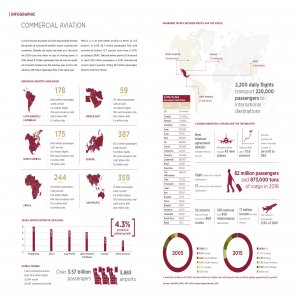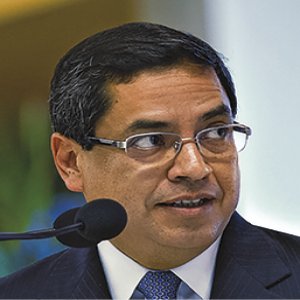Aligning to Trends Means Building Own Infrastructure

STORY INLINE POST
Q: What key trends in the air transportation market has UPS identified?
A: About 53 million tons of airborne cargo were carried in 2016, according to IATA, representing about 35 percent of global trade. UPS has aligned itself to the key trends in the air transportation market, which required the creation of its own infrastructure and airline division. In a continuously reconfiguring, globalized world, countries attempt to enter new markets and increase their presence in those where they already are, as goods and the way they are consumed change. UPS takes advantage of its global presence to help its clients achieve their objectives and gain international recognition.
Everybody wants deliveries made as quickly as possible in the logistics market. This has a bearing on whether a client decides to fly their goods instead of sending them by boat or by terrestrial means. Companies that position themselves in the market are those that can produce and deliver to clients the fastest. UPS helps its customers with guaranteed services that ensure a timely delivery.
Q: What are the main drivers behind the acceleration of the air cargo market?
A: The air cargo transportation sector remained stagnant for several years until late 2016 but demand is now on the rise, according to IATA. Technological advances have a significant impact on how trade is carried out. For instance, demand for national flights in countries like India and China is growing at a double-digit rate as a consequence of the increasing need to move goods much quicker. As the demand for national flights rises, the demand for airplanes also increases. For UPS, this translates into an increasing need to transport aircraft pieces and related goods.
The growing demand for cargo transportation is also due to new manufacturing models. Companies used to manufacture in one country and send finished goods to consumer countries. But today manufacturing is more complex as companies are based in one country, manufacture in a second, while goods come from a third, the assembly is done in a fourth and the target market is a fifth. This increasing complexity provides challenges for UPS, especially as most of its clients work under the just-in-time and zero-inventory schemes. UPS offers guaranteed services. Our clients can trust that they will receive their products at a specific time. There are several Key Performance Indicators (KPIs) the company follows so that every step of this process is properly structured and measured. We cannot fail to meet our delivery agreements because that would entail both operational problems and bad KPI results.
Q: How does UPS differentiate itself from other air logistics companies?
A: UPS has direct representation in over 220 countries and territories instead of virtual offices or outsourced services. Also, UPS invests US$1 billion in technology per year and has a pool of developers focused on coming up with new solutions to add value to its clients’ processes. UPS has developed digital platforms where clients can track a package, container or shipment without having to depend on less-advanced communications via email. In terms of trade documentation, UPS offers customs services alongside its shipping solutions. Having UPS do both the transportation and customs clearing both in Mexico and in the destination of the shipment is easier for clients. Also, paying attention to aerospace customers and their behavior enables us to increase our presence in the areas where we are needed.
Q: How has UPS adapted to cater to the e-commerce trend and what are its expectations for this area?
A: E-commerce is not a new thing for UPS Global. This is an advantage for UPS in México because the company can benefit from the experience and technology previously acquired or developed for other countries. The main challenge is adapting solutions to Mexico as the country has its own specific infrastructure and consumer habits. Several UPS clients that used to stick to traditional distribution channels are starting to open their own online stores. Their new B2B and B2C trade brings new challenges and opportunities for UPS. Another important challenge is that clients are rarely at home today as shifts are longer and everybody in the household works. For that reason, UPS invested in the development of a personalized system called UPS My Choice that enables recipients of packages and shipping to choose an address and delivery time to receive their goods. In terms of infrastructure, UPS announced an increase in its number of shipping centers to more than 70. These centers add up to more than 700 access points in Mexico. In addition, we recently closed an agreement with MercadoLibre that will help this e-commerce company with customer satisfaction.

Q: What technologies does UPS plan to introduce to the logistics sector?
A: We are introducing more alternative-fuel vehicles into Mexico and other countries to reduce our environmental impact. UPS is also implementing 3D printers in some of its shipping centers so clients can bring in digital storage devices and print and send their designs. Delivery drones are still in the beta phase. Several tests are being carried out in the US, specifically for humanitarian deliveries of medicine. But because there are no regulations on these devices, issues of privacy still need to be addressed.
Q: What specific services has UPS designed for aircraft parts manufacturers and maquiladoras in Mexico?
A: There are two services that have been well-received in manufacturing, specifically for industrial manufacturing and the retail, high-tech and automotive industries. First, the UPS Worldwide Express Freight is a service for palletized cargo that crosses borders. It is a guaranteed service in which shipped pallets are treated as a regular package. UPS can offer nextday delivery for shipments between Mexico and the US and two-day delivery for shipments between Mexico and Europe and Asia. In 2016, UPS entered more areas offering import/ export services because manufacturing services require these kinds of solutions. The second service, UPS Expedited Ground Freight is a hybrid terrestrial service. All the transport operations take place on the ground but customs clearance takes place in the internal airports of each country. It is hybrid because it receives the customs treatment usually applied to aerial shipping. This mix makes the clearance process much faster than doing it through the border. Several UPS aerospace clients, particularly those based in Chihuahua, Tijuana and Monterrey, have benefited from this model because they can use the terrestrial infrastructure to move their goods faster and at a good price.
Q: How will the renegotiations of NAFTA affect air logistics companies like UPS?
A: UPS is pure commerce. We have 237 “brown tail” airplanes, 420 charters and 1,090 daily international flights. In Mexico, UPS has three brown tail airplanes flying from Monday to Friday to UPS’ global hub in Louisville, Kentucky, and charters in several Mexican airports. Our more than 25 years in the Mexican market have taught us that trade and the free exchange of goods boost economic growth. The US is our main driver as 80 percent of our goods in Mexico is destined to this market. Therefore, UPS has assigned a group of people to work directly with the Congress in Washington and other authorities to generate an agenda that benefits all parties involved.
























